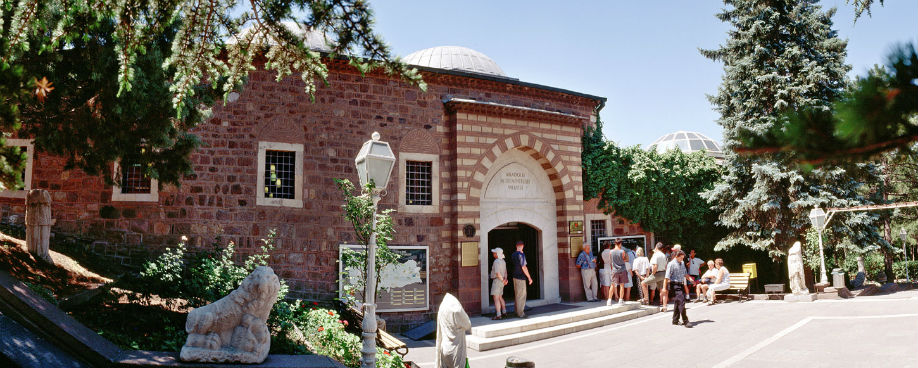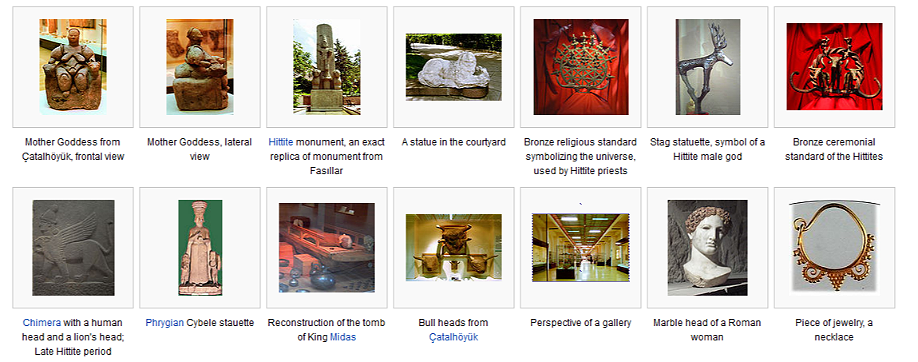The superb Museum of Anatolian Civilisations is the perfect introduction to the complex weave of Turkey’s ancient past, housing artefacts cherry-picked from just about every significant archaeological site in Anatolia.
The museum is housed in a beautifully restored 15th-century bedesten (covered market). The 10-domed central marketplace houses reliefs and statues, while the surrounding hall displays exhibits from the earlier Anatolian civilisations: Palaeolithic, Neolithic, Chalcolithic, Bronze Age, Assyrian, Hittite, Phrygian, Urartian and Lydian. The downstairs sections hold classical Greek and Roman artefacts and a display on Ankara’s history. Get there early to avoid the flood of tour groups and school parties.
The exhibits are chronologically arranged in a spiral: start at the Palaeolithic and Neolithic displays in the room to the right of the entrance, then continue in an anticlockwise direction, visiting the central room last.
Items from one of the most important Neolithic sites in the world Çatalhöyük, southeast of Konya – are displayed here. There’s a mock-up of the inside of a dwelling typical of those uncovered at the site, one of the most famous mother goddess sculptures unearthed from the excavations and wall paintings of hunting scenes.
Also on show are many finds from the Assyrian trading colony Kültepe, one of the world’s oldest and wealthiest bazaars. These include baked-clay tablets found at the site, which dates to the beginning of the 2nd millenium BC.
One of the striking Hittite figures of bulls and stags in the next room used to be the emblem of Ankara. The Hittites were known for their relief work, and some mighty slabs representing the best pieces found in the country, generally from around Hattuşa, are on display in the museum’s central room.
Most of the finds from the Phrygian capital Gordion, including incredible inlaid wooden furniture, are on display in the museum’s last rooms. The exhibits also include limestone blocks with still-indecipherable inscriptions resembling the Greek alphabet, and lion- and ram-head ritual vessels that show the high quality of Phrygian metalwork.
Urartian artifacts are also on display here. Spurred by rich metal deposits, the Urartians were Anatolia’s foremost metalworkers, as the knives, horse-bit, votive plates and shields on display demonstrate. There are also terracotta figures of gods in human form, some revealing their divine powers by growing scorpion tails, and neo-Hittite artefacts.
Downstairs, classical-period finds and regional history displays provide a local picture. Excavations have unearthed a Roman road near the Column of Julian, and Ankara has its own ‘missing link’, the 9.8-million-year-old Ankarapithecus (a 30kg, fruit-eating primate).




As noted by others, the renovations limit the amount of history on display including some of their more famous holdings. That being the case, you may be left hungering for more depending on your taste for early history. The ticket office does however, alert you that only two rooms are open and for that reason the audio guide is offered…
My husband and I were here in 2009. I found it interesting to view so many things from different civilizations. I don't recall seeing any renovations being done, so I don't know when the other reviewers were there. I especially enjoyed seeing their collection of clay tablets with envelopes and see who they were written by. My notes say that…
It was great to see the actual artifacts I have been reading about for the last twenty years.
This is a must-see on any visit to Ankara: stuffed full of the most incredible antiquities, it's almost enough to give you a brain "overload" as there are so many exhibits in a small space.
That said, when we visited, much of the museum was undergoing renovation, so a lot of exhibits had been moved into the main hall, making…
Beautifully laid out with wonderful examples of antiquities. It is undergoing some renovation at present and that does bunch up things a little. But there are sculptures and figurines from many of the civilizations who left their mark on this area through the millenia. Well worth a visit.
Half of the museum is closed in early 2013, which makes it less worthwhile if you are not nearby. Check the web for re-opening date. The museum houses some of the archeological finds from around the country. There is a pleasant gift shop near the entry.
One can take the bus on Ataturk Blvd. north to the equestrian statue at…
Perfect finish after touring the northern Black Sea and Inner Anatolia – in a beautifully lay-out restored building in a wonderful vaulted roof.
Too bad that only 2 of the 5 halls were opened….
This museum was a disappointment and could not compare to the archaeological museum in Istanbul. Half the museum was closed when we were there, but I looked through a book on it and found very little of much interest. There seems to be a fairly large collection of neoliithic but almost nothing of Troy and not that much that was…
This is the museum, f you are really interested in old, really old.
Anatolian Civilazations Museum is important to understand old historical condition of Anatolia. I strongly recomended to see this museum.